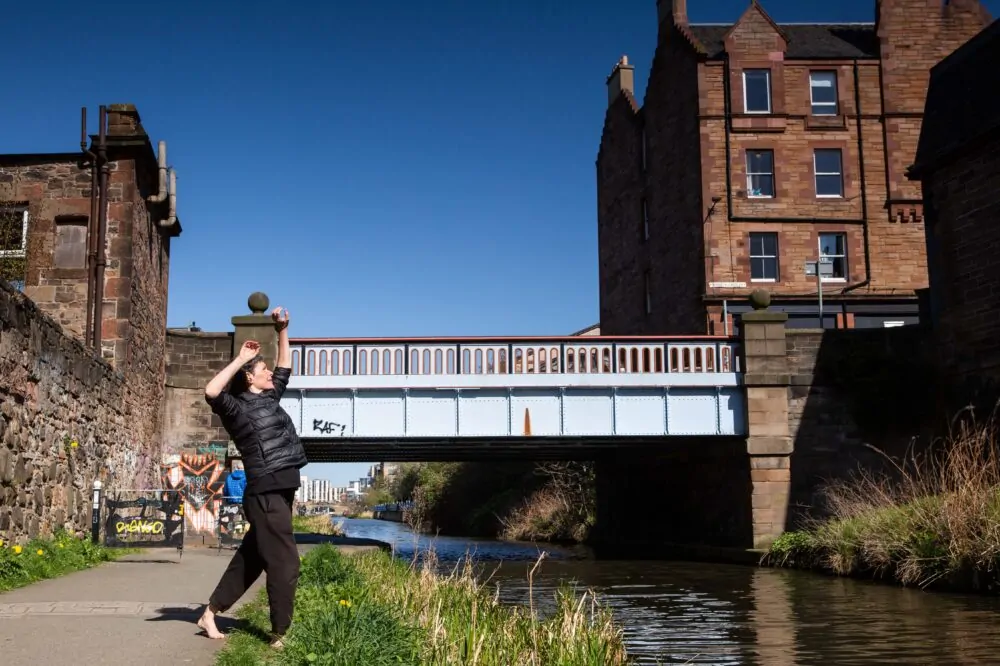Waves of Inspiration: Art on the Union Canal

SCAN caught up with artists Emmie McLuskey, Hannan Jones, and Maeve Redmond to discuss their work on the Associate Artist Programme at this year’s Edinburgh Art Festival: we talked local history, botany, industry, and how the communities of Wester Hailes inspired them.
“How can you work with local communities with this big international festival going on?” This was the question artist Emmie McLuskey posed to herself when she was selected as Associate Artist for this year’s Edinburgh Art Festival, launching 28 July—and the results sound promising. Ramblers along the banks of the Edinburgh-to-Glasgow Union Canal this summer will find a section of their route brought to life with art.
Between Lochrin Basin in central Edinburgh and the community of Wester Hailes, 3.5 miles to the south-west, visitors can enjoy aquatic soundscapes echoing from underneath bridges, new signage honouring the unnamed workers who cut the canal from the landscape, and even a dance-based procession along part of the waterway. An artist’s print will help audiences get to know the social history of the canal through its plant-life.
Glasgow-based McLuskey is known for her collaboration with artists using different media, so was the ideal person to take up the mantle of Associate Artist, who each year assembles a team working across different artforms to ignite new ideas. “What comes out during the festival is going to be a surprise to all of us,” says Emmie to SCAN. “When you’re working in a public space, you have no choice but to work with the surrounding community and local area, and I think that’s an amazing thing.”
She’s talking about the unusual set-up for this year’s Associate Artist Programme, which has seen Emmie and her team of fellow artists – Hannan Jones, Maeve Redmond, and Amanda Thomson – base themselves along the canal to learn from local community groups and experts on different aspects of local history and identity. With the canal celebrating its 200th anniversary this year, festival organisers were keen to allow this kind of deep engagement. The artists have also got a keen sense of the many and varied lives lived along the banks. “There’s no specific type of person who’s present on the canal,” says Jones, who also chatted to SCAN. “There’s people doing sports, people just wandering along, fishermen…” McLuskey agrees: “the union canal is a meeting place for all kinds of people, but everyone’s in transit. It’s not this static, unchanging place.”
Hannan Jones’s work, Surface Bounce and Cycles, uses underwater recording equipment to give audiences a sense of the relationship between the sub-aquatic animal and plant worlds of the canal and the human world above water. The influence of local community on this work was huge. “Having discussions with people who lived and worked or hung out along the canal really allowed me to see things from outside my own perspective,” she says. In particular it was a chance conversation with a local resident, “sitting next to me on a jetty testing the water to see if it was clean enough to swim,” who set off the idea of exploring underwater realms.
Jones’s piece is accompanied by Maeve Redmond’s The Mathematical River, a graphic work created with a local sign-painter which pays homage to the “navvies” who build the canal. None of their names are recorded, Redmond tells us, but “some of them would have lost their lives to the project or had a hard time sleeping by the banks during the job.” Meanwhile, Janice Parker will create a series of movement works along the water during the final two weeks of the festival (Not Brittle, Not Rigid, Not Fixed). The programme is rounded off with Amanda Thomson’s Mainly in Sinuousities, a double-sided print work using the botanical identity of the canal-banks as a lens on its human history: how are different stories of migration and industry told through plantlife?
These are just the latest chapters in a long-term programme of engagement between the Festival and Wester Hailes. Artist Jeanne van Heeswijk has been working with Wester Hailes and WHALE Arts – a local arts group cementing links with the festival – since 2019. Together they’ve devised a range of projects envisaging possible futures for the area, some of which will be shared during the artist’s opening keynote at EAF on 29 July. Artists Pester and Rossi have also been situated in the area over a long period to produce their sound- and sculpture-based work Finding Buoyancy. A temporary community hub, Watch this Space, facilitated by the Community Wellbeing Collective, has come together to host events exploring issues like economic inequality and the role of creativity in healing and social care.
This hub, like the guided walks and tours the artists were offered, has been vital in providing ideas, knowledge, and creative inspiration. The festival’s relationship with canal-side communities has been positive for all involved. Art enriches communities, but we shouldn’t forget that communities enrich art, too.
